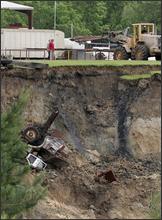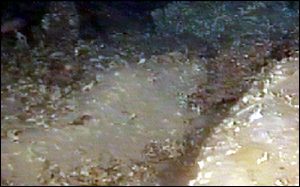A sinkhole opened as a crack in the road yesterday in Liberty County, Texas. Today it’s 550 metres across and has swallowed a truck.
It’s possible that an old salt dome has collapsed—dissolved away under the ground.
Television news footage showed a tractor, some oil field equipment and some telephone poles falling into the sinkhole as it grew near Daisetta, which has a population of around 1,000 and is located about 60 miles northeast of Houston….
Officials are trying to determine what prompted the sinkhole near the Liberty County community. But its history as a once booming oil town might be to blame.
The ground might have caved in because of the collapse of an old salt dome where oil brine and natural gas are stored underground, officials said. Daisetta sits on a salt dome, one of the most common types of traps for oil.
Sinkholes are rare and often take up to two weeks to stabilize, said Geoffrey Paine, a geologist and geophysicist with the University of Texas.
Update: the sinkhole is now 800m across but it has slowed down its growth.
A day earlier, Branch, other officials and residents had watched as large chunks of earth, as well as the oil field equipment, trees and vehicles that sat on them tumbled into the crater. The mixture of oil and mud at the bottom of the sinkhole made it look like a tar pit.
Carl Norman, a geologist working with officials, said he planned to measure the change of ground elevation around the sinkhole over the next few days to try to determine whether it is still growing or is now stabilized. But he added, “It will be at least three months before we can say if it’s stable or not.”
…Don Van Nieuwenhuise, a geosciences professor at the University of Houston, said oil production usually doesn’t affect the integrity of a salt dome. He said he thinks the sinkhole is probably related to saltwater waste that is being stored underground in the area. The saltwater is a byproduct of oil production and has to be stored underground so it won’t contaminate water supplies and the environment.
UPDATE: YouTube video
Collection of videos from a spam news aggregator:












